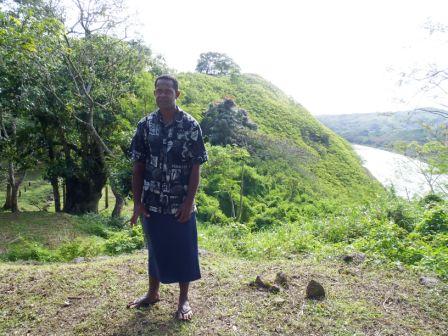The cannibal isles

VulcanSpirit
Richard & Alison Brunstrom
Tue 16 Oct 2012 09:51
|
Before the arrival of the missionaries in
1835 Fiji was known as the Cannibal Isles with a truly fearsome reputation.
Cook bypassed the place and went istead to Tonga which he named, in contrast,
the Friendly Isles (a misnomer if ever there was one because he was mistaken;
the Tongans fully intended to eat him after wining & dining him and his crew
for three weeks but Cook, entirely ignorant of the plan, left by coincidence the
day before the massacre was to take place).
Near Singatoka is a hillfort. Here is the
view:
 The fort is exactly like those found in the UK,
perched on the top of a steep hill overlooking the main arterial river. The
people lived in stone huts with thatched roofs, and you can see the carefully
preserved remains. The whole village could be transported to Wales and would be
indistinguishable from those already there dating from three thousand years ago
and more. The difference is that this one was built in the 1860s, just before
the British arrived.
A chief from Tonga arrived with a large band of
warriors and took over this area. Their religion involved human sacrifice, every
full moon. You couldn't eat members of your own tribe, so you had to capture
warriors from neighbouring tribes - who of course were all doing the same thing.
A state of perpetual warfare existed at European contact, which may be one
reason why the missionaries were so successful. A religion that brought peace,
as it did, must have seemed very attractive. The Fijians seem to have eaten only
one missionary, a Reverend Baker who went upcountry (in fact, up this very river
to the hills in the background) in the late 1860s to try to convert the hill
tribes. They ate him, and even his shoes. This so incensed the converted coastal
tribes that they called for British assistance which was promptly provided. By
the mid-1870s the area was so peaceful that the Briish were able to build a
sugar cane railway which passed along the riverbank right under the fort.
The tribe of Tongan origin still live in the area.
This guy, who is custodian of the fort (which is a national monument) is the
great grandson of the original chief, and will in due course become not just
Chief of his village, but also Clan Chief and Paramount Chief of the tribe.
 He's a stout Methodist (simply because it was
Methodists that the London Missionary Society sent here), but unlike most people
in the Pacific Filjians do not pretend that history started with their
conversion to Christianity - they are confident enough to accept their past. But
tribalism is alive here; it continues to cause real problems although thankfully
to nowhere near the extent seen in Africa.
|